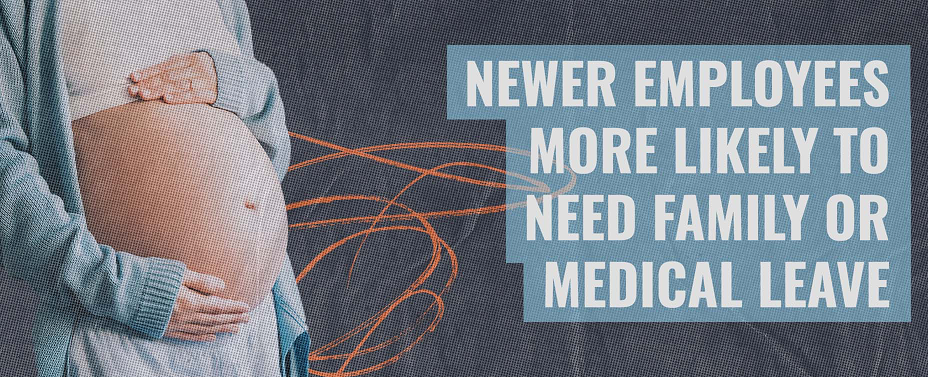
- 2024 year-end: BENEFITS
Statutory and paid leave claims
Report objectives
This report aims to summarize the present metrics for statutory claims, assess the landscape of the environment surrounding statutory claims administration, and benchmark our patterns against comparable industry research.
data parameters
Our practice team uses JURIS claims data to perform comparative analyses informed by their expertise and analytics. The data in this report is based on the calendar year, January through December, for each reporting year. Detailed analysis is included for California, Colorado, Connecticut, Massachusetts, New Jersey, New York, Oregon and Washington.Certain client data is excluded from book of business metrics to avoid overrepresentation of a single client.
Key observations
Statutory paid leave usage was highest among the 25–35 and 35–45 age groups. In 2024, there was a slight increase in usage for these groups from 38% to 39%.
Trends in overall length of service show the highest percentage of use among employees with less than three years of service, with continued growth in other categories including 5–10 years and 10–20 years.
Other points to note related to length of service:
| • | The “less than 3 years” category maintained a volume percentage of 32% in both 2023 and 2024. |
| • | The “5–10 years” category increased from 28% in 2023 to 29% in 2024. |
| • | The “10–20 years” category grew from 17% in 2023 to 18% in 2024. |
Separating out volume by state-paid leaves mirrors similar trends in age and length of service.

According to the U.S. Bureau of Labor Statistics, newer employees, particularly those with less than three years of service, are often in the age group that is more likely to need family and medical leave due to life events such as childbirth or serious health conditions. Additionally, the Center for American Progress highlights that access to paid family and medical leave is crucial for newer employees who may not have accumulated sufficient leave time through their employers. State-specific data from programs in California, New York and New Jersey also report higher usage rates among employees with shorter tenures.
New volume for statutory paid family leave
When looking at paid family medical leave (PFML) states, statutory disability claims mirror the data in our State of the Line report on disability claims. This report focuses on paid family leave (PFL) benefits as these benefits tend to be more varied among the states in terms of benefits, duration and usability. When looking at the states that Sedgwick administers private plans for New York and California are the two heaviest users of PFL benefits. It should be noted, however, that in 2024, both states saw a significant decrease in the usage of PFL benefits. We saw similar trends for Massachusetts and Washington.

Evaluating usage of paid family leave benefits based on years of service, a slight uptick was seen in employees with 5–10 years and 10–20 years of service. Considering that the data shows that the top reason for using paid family leave in most states is bonding, this means that employees in the 35–45 demographic may be using paid family leave benefits versus younger workers.

Paid family leave by state
New York
Over the last three years, paid family leave usage rates have been increasing year over year. This is being driven largely by the finance and healthcare industries. The manufacturing and services industries are flat year over year, and retail and transportation both are showing declines year over year.


Newborn bonding and family leave continue to lead the claims in New York, accounting for 98% of all claims in the state for the last three years. As noted above, given that employees with longer tenures are using the benefit more, data suggests that usage for family leave is the primary driver of this data. This could indicate a trend employers should review to determine if parental leave programs need to grow to be inclusive of all family care needs and not just newborn bonding.

California
While not increasing at the same rate as New York, California paid family leave benefits are slightly rising year over year. Given the recent weather and natural disaster events in California, this could be the reason for the slower pace of growth since many employees, especially in large metro areas like Los Angeles, were displaced due to events in the fourth quarter of last year.

Similar to New York, newborn bonding is the top claim reason in the state, accounting for almost 70% of the claims. While California has more reasons for family leave than New York, care for parent, spouse or child collectively make up the remaining 29% of claims, with care for parent being the top reason. Given that more families are now in a sandwich generation (meaning that children are caring for both their own children as well as their parents), we anticipate that this trend will continue and grow over the next few years.

Colorado
Colorado has completed its first year of benefits and like other states, newborn bonding and family leave are the most prominent reasons for leave. Of particular note, family care leave accounted for almost 40% of all Colorado paid family leave claims in 2024.
Volume is very low under this statutory paid leave – charts limited to overall volumes, industry and claim type.

Connecticut
While data is limited for Connecticut, overall claims volume appears to have stabilized over the last two years. Looking at the data, paid family leave was used the most in the second and third quarter, followed by the fourth quarter. Data did show unusually high usage in the second quarter of 2022, but this can be attributed to the launch of the Connecticut paid family leave benefit.
Volume is very low under this statutory paid leave – charts limited to overall volumes, industry and claim type.

Massachusetts
While the two main reasons for leave in Massachusetts are like other states, what’s interesting is that until 2024, family medical leave usage was either equal to or higher than newborn bonding. Given that COVID was still a major concern in early 2022, this data makes sense, but we did not see the separation between the benefits that was seen in other states.
Volume is very low under this statutory paid leave – charts limited to overall volumes, industry and claim type.

Oregon
In Oregon, family leave and newborn bonding claim volumes follow the trend of other states, but the variance between the two is the closest of any states. It should be noted that Oregon has the most expansive definition of family member of any paid family leave state, which may account for the closeness in benefit usage.
Volume is very low under this statutory paid leave – charts limited to overall volumes, industry and claim type.

Washington
As one of the first states with an integrated disability and paid family leave program, Washington is extremely stable in the reasons for usage. Newborn bonding is the key reason and while it increased 10% from 2022 to 2023, current levels have come down slightly. While trailing behind, there was an increase of over 8% from 2023 to 2024.
Volume is very low under this statutory paid leave – charts limited to overall volumes, industry and claim type.

Future considerations
Upcoming implementations and new states
In 2023, Oregon and Colorado implemented their plans. Delaware and Minnesota will roll out their programs on Jan. 1, 2026, followed by Maine on May 1, 2026. Maryland has indicated that they will postpone their program until 2028.

Additionally, six states (Tennessee, Virginia, Florida, Texas, Alabama and Arkansas) have passed group insurance paid family leave programs, with Kentucky, North Carolina and Pennsylvania expected to follow. These programs allow carriers to offer group insured benefits attached to group disability products, presenting a challenge for employers due to varying offerings.
IRS guidance
The IRS recently issued guidance on how paid family and medical leave benefits are to be taxed by employers if the employer is using the state as a program administrator. While the guidance was welcomed, it failed to address how to handle taxation of benefits for private or voluntary plans by employers.
Regulatory changes
The new administration has made a priority of reducing what it calls regulatory oversight. This reduction of federal oversight could lead additional states to reevaluate paid family leave benefits. Maryland has already noted that the recent layoffs at the federal level are negatively impacting Maryland workers, which has caused a pause in the implementation of the program. When looking at other benefits, when layoffs are looming, there is an increase in benefits usage to either secure income, job protection or both. This could impact state programs in terms of utilization and future rate impacts if usage continues to increase.

